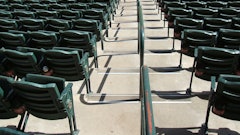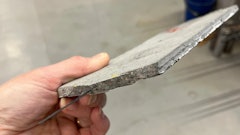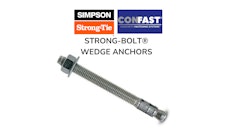
Payment for additional testing is often a point of contention on many jobsites, even though the ASCC-NRMCA "Checklist for the Concrete Pre-Construction Conference" includes the following questions that would help to resolve questions about payment responsibility:
- How do the project specifications handle additional testing? If additional testing is required how will the parties be notified?
- What investigative procedures will be used?
- Who will be employed to conduct additional testing and who employs them?
- How will the test results be evaluated?
- Who pays the costs of additional testing: If specifications are confirmed? If specifications are not confirmed?
To illustrate the need for getting early answers to these questions, imagine the following two situations:
- You finish a cast-in-place concrete project and several months later a mechanical subcontractor drills a hole in a slab on deck. He uncovers a void about one inch deep and less than one foot square under a cluster of congested reinforcing steel.
- On the same project, an opening for a machine foundation is cut in a slab on ground. The slab, with a design thickness of 6 inches, is found to be only 5 inches thick on one side of the opening.
You patch the void in the slab on deck. You also cut out concrete around the floor opening for the machine foundation until all sides are at least 6 inches thick, then replaced the concrete to a depth of at least 6 inches. Now, however, the engineer, owner, or general contractor wants you to pay for testing the entire slab on deck to detect other possible voids. They also want you to test the entire slab on ground for other possible thin spots. This despite the fact that "Specification for Tolerances for Concrete Construction and Materials (ACI 117-10) and Commentary" states the following regarding localized occurrences of reduced thickness for slabs-on-ground: "4.5.4.6 When corrective action is required, additional samples shall be taken in the vicinity of unacceptable results to establish the extent of corrective action."
They say the additional testing is needed because the two examples of nonconformance led them to believe that more of your work may be deficient.
There were quality assurance and quality control inspectors making observations and measurements during all placements, and your argument is that the voids or thin sections are isolated instances. You are willing to pay for repair of any further defects that are uncovered but don't believe you should have to pay for any further testing, especially on sections where no such defects are subsequently found. What is the best way to handle this problem?
 Internal voids or honeycombs must be repaired using methods described in the specifications. But does the presence of one or two such deficiencies justify a costly testing program charged to the concrete contractor?
Internal voids or honeycombs must be repaired using methods described in the specifications. But does the presence of one or two such deficiencies justify a costly testing program charged to the concrete contractor?
The fishing trip mentality
Unfortunately these "fishing trips" happen all too often when a defect is discovered during or after construction. They may be triggered by core tests resulting from low strength tests or situations similar to the ones described.
Most specifications describe repair materials and methods to be used. For instance, Section 3.16 of the 2008 AlA MASTERSPEC contains the following requirements:
- Perform structural repair of concrete, subject to Architect's approval, using epoxy adhesive and patching mortar.
- Repair materials and installation not specified above may be used, subject to Architect's approval.
That and sections in other commonly used construction specifications imply that some repair will be needed and that the contractor is expected to make the repairs at no additional cost. The specifications, however, should not require contractors to search for defects or pay to search for defects.
The following sections in ACI 301-05, Specifications for Structural Concrete, explain this as well.
- 1.7 - Acceptance of structure
- 1.7.1 General - Completed concrete work shall conform to applicable requirements of this Specification and the Contract Documents.
- 1.7.1.1 Concrete work that fails to meet one or more requirements of the Contract Documents but subsequently is repaired to bring the concrete into compliance will be accepted.
- 1.7.1.2 Concrete work that fails to meet one or more requirements of the Contract Documents and cannot be brought into compliance may be rejected.
- 1.7.1.3 Repair rejected concrete work by removing and replacing or by reinforcing with additional construction as required by the Architect/Engineer. To bring rejected work into compliance, use repair methods that will maintain specified strength and meet applicable requirements for function, durability, dimensional tolerances, and appearance as determined by the Architect/Engineer.
- 1.7.1.4 Submit for acceptance the proposed repair methods, materials, and modifications needed to repair the concrete work to meet the requirements of Contract Documents.
- 1.7.1.5 Contractor will pay all costs to bring concrete work into compliance with requirements of Project Specification.
Advice for the wary contractor
Check contract documents to make sure there are no contractual obligations for you to search for defects that aren't apparent. If ACI 301-05 is the specification cited, note the following sections, which indicate testing services, the costs for which are not borne by the contractor.
1.6.4.3. Additional testing services - When required by the Architect/Engineer, the Owner's testing agency will perform the following testing services at no cost to the Contractor:
- Inspect the concrete batching, mixing, and delivery operations;
- Inspect forms, foundation preparation, reinforcing steel, embedded items, reinforcing steel placement, and concrete finishing and curing operations;
- Sample concrete at point of placement and other locations as directed by the Architect/Engineer and perform required tests;
- Review the manufacturer's report for each shipment of cement, reinforcing steel, and prestressing tendons, and conduct laboratory tests or spot checks of the materials received for compliance with specifications; and
- Other testing or inspection services as required by the Architect/Engineer.
The last bulleted item would apply to the testing for voids in the slab on deck or thin spots in a slab on ground.
Section 1.6.4.4 of ACI 301.05 indicates testing services that the contractor is to pay for, as follows: 1.6.4.4 Other testing services as needed - The Contractor shall pay for the following testing services performed, when necessary, by the Owner's testing agency:
- Additional testing and inspection required because of changes in materials or mixture proportions requested by the Contractor; and
- Additional testing of materials or concrete occasioned by failure to meet specification requirements.
Note the underlined portion of the second bulleted requirement. This portion may hold you responsible for testing costs even if no evidence was found after the initial specification noncompliance was discovered and repaired.
If the engineer, owner, or general contractor wants further testing, they should pay for it. If evidence of other specification nonconformance is found (and confirmed when concrete is removed) contractors would be obligated to pay for the repair and the portion of the testing that resulted in discovery of the nonconformance. For instance, if an impact-echo device was used to survey the entire slab on deck and only one square foot of defect was found in the 10,000 square feet surveyed you would pay for the repair of the 1-square-foot defect, but your portion of the survey costs would be 1/10,000 of the total testing cost.
To reinforce this opinion, here is a section of an excellent contract document that describes the Contractor's Responsibility for Testing Laboratory Services:
Tests for Suspected Deficient Work: If in the opinion of the Owner, Architect, or Engineer any of the work of the Contractor is not satisfactory, the Contractor shall furnish and pay for all tests that the Owner, Architect, or Engineer deem advisable to determine its proper construction. The Owner shall pay all costs if the tests prove the questioned work to be satisfactory. [Emphasis ours]
Ideally you can bring the ASCC-NRMCA checklist to the pre-construction meeting. Then you reduce the chances of being stuck with paying for the rods, bait, and time spent fishing when no fish are caught.






























